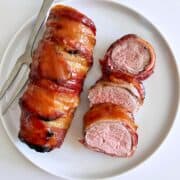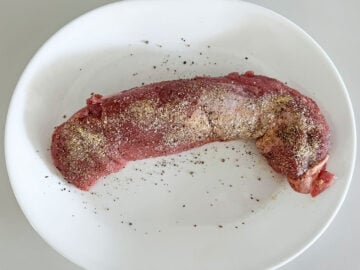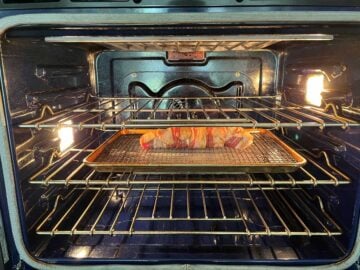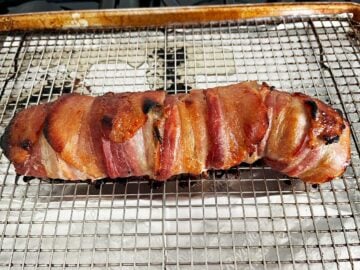
Honey-Glazed Bacon Wrapped Pork Tenderloin
This bacon wrapped pork tenderloin is life-changing. The bacon adds flavor and fat to the lean pork, making it juicy and flavorful.
Servings 4 servings
Calories 391kcal
Ingredients
- Oil spray for the pan
- 2 tablespoons honey or sugar-free syrup
- 2 tablespoons Dijon mustard
- 1 pork tenderloin 1¼ pounds
- 1 teaspoon Diamond Crystal kosher salt or ½ teaspoon of any other salt, including Morton kosher salt
- ¼ teaspoon black pepper
- 1 teaspoon garlic powder
- 6 bacon strips
Instructions
- Preheat the oven to 450°F. Line a roasting pan or a rimmed baking sheet with foil and fit it with a greased roasting rack.

- In a small bowl, mix together the honey and Dijon mustard. Divide the mixture into two equal portions. Set aside.

- Pat the pork dry with paper towels. Sprinkle the kosher salt, black pepper, and garlic powder all over the pork.

- Wrap the tenderloin with the bacon strips, wrapping each bacon slice crosswise around a section of the pork and securing the end by tucking it underneath.

- Brush the top and sides of the tenderloin with half of the honey-Dijon glaze.

- Place the wrapped and glazed pork on the prepared roasting rack and place it in the hot oven.

- Roast the pork until the bacon is nicely browned, for about 30 minutes. Check its internal temperature - it will likely be undercooked at this point.

- Cover the tenderloin loosely with foil to prevent the bacon from burning. Return it to the oven for about 10 more minutes, until an instant-read thermometer registers an internal temperature of 145°F.

- Remove the tenderloin from the oven. Allow it to rest for 15 minutes.

- Brush the pork with the remaining honey-Dijon glaze, slice, and serve.

Video
Notes
- In 2011, the USDA lowered its safe temperature for whole cuts of pork from 160°F to 145°F, with a 3-minute rest period. So we can now cook whole cuts of pork to a wonderfully juicy, slightly pink medium temperature.
- I typically use a 1.25-pound pork tenderloin in this recipe. If yours is bigger - they can sometimes be as big as 1.5 pounds - roast it for 5-10 minutes longer and check with a thermometer to make sure it's done.
- Oven temperatures and pork tenderloin sizes vary. The only way to know for sure when the tenderloin is done is by using an instant-read thermometer. This will ensure you don't undercook or overcook the pork.
- You can keep the leftovers in an airtight container in the fridge for 3-4 days. Reheat them, covered, in the microwave at 50% power. If you'd like to crisp up the bacon, reheat the leftovers in a 350°F oven until heated through.
Nutrition
Serving: 0.25recipe | Calories: 391kcal | Carbohydrates: 9g | Protein: 47g | Fat: 16g | Saturated Fat: 4g | Sodium: 782mg | Fiber: 0.1g | Sugar: 8g